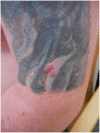Cutaneous Malignancies in Tattoos, a Case Series of Six Patients
- PMID: 34898571
- PMCID: PMC8628776
- DOI: 10.3390/curroncol28060398
Cutaneous Malignancies in Tattoos, a Case Series of Six Patients
Abstract
Background: A variety of side effects following the tattooing of the skin were reported over the years. Analytical studies showed that some tattoo inks contain harmful compounds.
Methods: We presented six patient cases with cutaneous malignancies in tattooed skin and performed an extensive literature research.
Results: Two patients with black ink tattoos that were diagnosed with malignant melanoma raises the number of described cases to 36 patients. One of the patients developed an immunologic reaction limited to the tattoo area after treatment with a targeted immune therapy. In the other patient, the malignancy (malignant melanoma) was fatal. Basal cell carcinoma was seen in four patients with tattoos containing varying ink colors (black, green, red). This increased the number of described patient cases to 18. Although some ink components and their cleavage products have carcinogenic properties, epidemiological evidence for a causative correlation fails. Further epidemiologic studies on tattoos and malignancies, as well as on the appearance of naevi in tattoos, are necessary. Determining the type of mutation might be helpful to separate sun-induced tumors from skin cancers due to other pathogenic mechanisms.
Keywords: basal cell carcinoma; endocrine disruptors; melanoma; polyaromatic hydrocarbons; squamous cell carcinoma; tattoo; tattoo ink; tumor promotion.
Conflict of interest statement
The authors declare no conflict of interest.
Figures








Comment in
-
Nonmelanoma skin cancer arising on tattoos.Int J Dermatol. 2023 Mar;62(3):e155-e156. doi: 10.1111/ijd.16381. Epub 2022 Aug 7. Int J Dermatol. 2023. PMID: 35933654 No abstract available.
References
-
- Anforderungen der Hygiene beim Tätowieren, (2002, überarbeitet 2017) [(accessed on 24 January 2020)]. Available online: https://www.awmf.org/uploads/tx_szleitlinien/029-024l_S1_Anforderungen-H....
-
- Ricci F., Paradisi A., Maier S.A., Kovacs M., Podda M., Peris K., Abeni D. Melanoma and tattoos: A case report and review of the literature. Eur. J. Dermatol. 2017;28:50–55. - PubMed
-
- Arbeitsgemeinschaft der Wissenschaftlichen Medizinischen Fachgesellschaften—Ständige Kommission LA-RL. Leitlinienprogramm Onkologie (Deutsche Krebsgesellschaft, Deutsche Krebshilfe, AWMF): Diagnostik, Therapie und Nachsorge des Melanoms; Lang-Version 3.2. 2019:280. [(accessed on 24 January 2020)]. Available online: https://www.leitlinienprogramm-onkologie.de/fileadmin/user_upload/Downlo....
-
- Nolan K.A., Kling M., Birge M., Kling A., Fishman S., Phelps R. Melanoma arising in a tattoo: Case report and review of the literature. Cutis. 2013;92:227–230. - PubMed
MeSH terms
Substances
LinkOut - more resources
Full Text Sources
Medical

